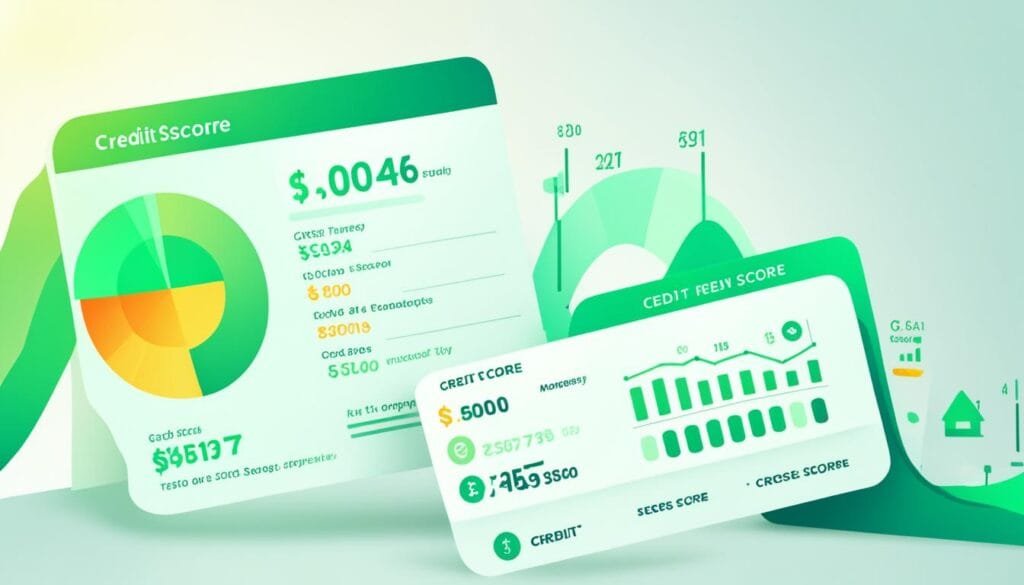Are you stuck in a cycle of financial stress and looking for a way out? You’re not alone. Many individuals and families face challenges when it comes to managing their finances effectively. But the good news is that there are strategies you can implement to embark on a journey towards financial recovery and achieve fiscal health.
Let me share a story with you. Meet Sarah, a hardworking professional who found herself drowning in debt and struggling to make ends meet. She had accumulated credit card debt, student loans, and a mortgage, all of which seemed overwhelming.
Determined to turn her situation around, Sarah sought advice from financial experts and implemented a series of financial recovery strategies. She started by creating a budget, tracking her expenses, and cutting back on unnecessary spending. She also explored debt reduction advice and discovered strategies to negotiate lower interest rates and pay off her debts more efficiently.
As Sarah began to regain control over her finances, she also focused on long-term financial planning. She researched investment strategies, learned about wealth building techniques, and set clear financial goals for herself. With a clear roadmap in place, she was able to make informed decisions about her money and take steps towards financial independence.
Over time, Sarah’s dedication and smart money moves paid off. She gradually paid off her debts, built an emergency fund, and even started investing in her future. What seemed like an impossible situation transformed into a journey of financial recovery and empowerment.
Like Sarah, you too can take charge of your financial future. By implementing money management tips, budgeting techniques, and debt reduction advice, you can pave the way for financial stability and wealth accumulation. It’s never too late to start, and with the right strategies, you can achieve your financial goals and attain the peace of mind you deserve.
Key Takeaways:
- Implement budgeting techniques to track your expenses and identify areas for saving.
- Explore debt reduction advice to negotiate lower interest rates and pay off debts efficiently.
- Learn about investment strategies and wealth building techniques for long-term financial planning.
- Set clear financial goals to guide your financial decisions and prioritize your spending.
- Take proactive steps towards financial independence and achieve fiscal health.
The Unsustainable Fiscal Path
The United States is currently on an unsustainable fiscal path, with federal debt growing faster than GDP. Projections indicate that debt will continue to rise, reaching its highest point in history by 2028.
The key drivers of federal spending are health care programs and Social Security, both of which are projected to grow substantially in the coming years. Total health care spending is increasing faster than the economy, driven by an aging population and rising health care costs. Medicare spending is projected to reach $1 trillion per year by 2023, while combined federal and state Medicaid spending is set to reach $1 trillion by 2027. Social Security spending is also on the rise due to factors such as longer lifespans and slower labor force growth. Without changes, major trust funds, including Medicare’s Hospital Insurance Trust Fund, are projected to be depleted within the next 15 years.
To illustrate the current fiscal situation, the following table presents the spending projections, debt-to-GDP ratio, and estimated health care spending and Social Security costs:
| Year | Federal Debt | Spending Projections | Debt-to-GDP Ratio | Health Care Spending | Social Security |
|---|---|---|---|---|---|
| 2021 | $26.95 trillion | $6.59 trillion | 128.9% | $1.3 trillion | $1.1 trillion |
| 2025 | $33.39 trillion | $8.72 trillion | 139.5% | $1.7 trillion | $1.3 trillion |
| 2030 | $41.27 trillion | $11.27 trillion | 155.4% | $2.1 trillion | $1.7 trillion |
| 2035 | $50.62 trillion | $14.93 trillion | 177.4% | $2.7 trillion | $2.2 trillion |
| 2040 | $61.51 trillion | $19.93 trillion | 206.2% | $3.5 trillion | $2.9 trillion |
| 2045 | $74.07 trillion | $26.54 trillion | 244.8% | $4.5 trillion | $3.7 trillion |
| 2050 | $88.45 trillion | $35.99 trillion | 288.5% | $5.8 trillion | $4.8 trillion |
The table clearly illustrates the alarming trajectory of federal debt, with the debt-to-GDP ratio increasing over time. Health care spending and Social Security costs are projected to grow significantly, putting further strain on the federal budget.
Without significant changes to the current fiscal trajectory, the United States will face severe financial challenges in the future. It is imperative that policymakers take action to address the unsustainable fiscal path and ensure the long-term financial stability of the country.
The Consequences of Rising Debt
Rising debt levels have various consequences for the federal budget and the overall economy. High and increasing debt increases the risk of a fiscal crisis and can lead to a loss of confidence in the government’s ability to repay its debt. It can also limit policymakers’ capacity to support the economy during downturns or unexpected events.
Persistently low interest rates have allowed for lower spending on net interest, but as the debt continues to grow, net interest is projected to become the largest category of spending by 2050. The compounding interest on the rising debt poses significant challenges to the sustainability of the economy.
“Rising debt levels have the potential to trigger a fiscal crisis and limit the government’s ability to provide support during emergencies.” – Expert
The uncertainty surrounding the debt limit also poses challenges, as it can increase borrowing costs and disrupt the market for Treasury securities. When the debt ceiling is reached, the government faces difficulties in meeting its financial obligations, risking default and destabilizing the economy.
To address these challenges and avoid severe consequences, a comprehensive fiscal strategy is necessary. This strategy should focus on reducing debt, controlling spending, increasing revenue, and implementing measures to ensure long-term fiscal sustainability.

It is essential to recognize the potential ramifications of rising debt and take proactive measures to mitigate the risks. By implementing effective fiscal policies and adhering to responsible financial practices, governments can safeguard the economy and maintain stability.
The Need for Fiscal Rules and Targets
To address the unsustainable fiscal path, it is important to establish fiscal rules and targets. These rules can help guide policymaking and ensure that the government takes necessary actions to maintain fiscal health.
One suggestion is to include a debt-to-GDP target as part of a broader fiscal plan. Congress and the administration need to consider revenue and spending strategies in formulating this plan. Factors such as tax expenditures, entitlement programs, discretionary spending, and debt management should all be taken into account.
By implementing a comprehensive fiscal plan, the government can work towards long-term sustainability and financial stability.
Opportunities for Executive Agencies and Congress
Executive agencies and Congress have the power to contribute significantly to the fiscal health of the nation through various actions and reforms. By focusing on key areas such as reducing the tax gap, addressing improper payments, implementing program reforms, and improving government performance and accountability, they can generate financial benefits and improve the overall fiscal health of the country.
Reducing the Tax Gap:
The tax gap, which represents the difference between taxes owed and paid, is a significant concern for fiscal health. By implementing strategies to narrow this gap, such as improving tax enforcement and compliance measures, the government can ensure that more tax revenue is collected and allocated towards critical initiatives and reducing the budget deficit.
Addressing Improper Payments:
Improper payments amount to billions of dollars annually, posing a significant drain on the government’s resources. By implementing measures to identify and reduce these improper payments, executive agencies and Congress can generate substantial savings and redirect those funds towards initiatives that promote fiscal health and economic growth.
Implementing Program Reforms:
Program reforms are essential for optimizing efficiency and effectiveness within government agencies. By identifying areas of improvement and implementing reforms that align with fiscal health objectives, executive agencies and Congress can streamline processes, eliminate waste, and enhance the overall performance of government programs, resulting in long-term financial benefits.
Improving Government Performance and Accountability:
Enhancing government performance and accountability is crucial for ensuring fiscal health. By adopting measures that promote transparency, efficiency, and accountability, executive agencies and Congress can build trust with the public and ensure that taxpayer dollars are being utilized effectively and responsibly.
Financial Benefits of Executive Agency and Congressional Actions
| Action | Financial Benefit |
|---|---|
| Reducing the tax gap | Increased tax revenue, reduced budget deficit |
| Addressing improper payments | Savings of billions of dollars annually |
| Implementing program reforms | Streamlined processes, elimination of waste, enhanced program performance |
| Improving government performance and accountability | Increased transparency, efficient use of taxpayer dollars |
By narrowing the tax gap, addressing improper payments, implementing program reforms, and improving government performance and accountability, executive agencies and Congress can actively contribute to the fiscal health of the country. These actions will generate financial benefits, promote long-term sustainability, and secure a healthier and more stable economic future.

Enhancing Social Safety Nets and Planning Discretionary Policies
Enhancing social safety nets is crucial, particularly in light of the vulnerabilities exposed by the COVID-19 pandemic. Countries need to provide broad coverage and adequate benefits to vulnerable groups in a progressive manner. These safety nets not only stabilize people’s incomes during crises but also preserve work incentives and support individuals in finding employment, accessing healthcare, and pursuing education and training.
Additionally, planning discretionary policies can help stimulate demand and support economic recovery. For instance, governments can consider temporary payroll tax cuts to incentivize firms to hire and time-bound value-added-tax reductions to encourage spending.
Finally, public investment in areas such as health care, infrastructure, and climate change is necessary for the long-term stability and prosperity of the economy.
Example: The Impact of Social Safety Nets in Country X
| Program | Beneficiaries | Services Provided |
|---|---|---|
| Unemployment Benefits | Job seekers and those who lost their jobs | Financial support to cover basic needs while looking for work |
| Healthcare Access Program | Low-income individuals and families | Medical, dental, and mental health services at reduced or no cost |
| Education and Training Grants | Disadvantaged individuals seeking to improve their skills | Financial assistance for tuition, books, and vocational training |
How Can Improving My Credit Score Help in Financial Recovery Strategies?
Improving your credit score basics financial health is crucial for successful financial recovery strategies. A higher credit score can lead to better interest rates on loans and credit cards, saving you money in the long run. It also signals to lenders that you are a responsible borrower, making it easier to secure new lines of credit.
Conclusion
Achieving fiscal health and long-term sustainability requires the implementation of effective financial recovery strategies. By addressing the unsustainable fiscal path, enhancing social safety nets, and planning discretionary policies, governments can guide their countries towards fiscal health and economic stability. It is essential for policymakers to take proactive measures to ensure long-term fiscal sustainability and mitigate potential risks. With a comprehensive approach to financial recovery, it is possible to achieve a path to fiscal health and secure a stable and prosperous future.
FAQ
What are financial recovery strategies?
Financial recovery strategies are plans and techniques designed to help individuals or organizations overcome financial challenges, rebuild their finances, and achieve financial stability. These strategies may include money management tips, budgeting techniques, debt reduction advice, and financial planning strategies.
How can I manage my money effectively?
To manage your money effectively, it is important to create a budget, track your expenses, prioritize your financial goals, save money regularly, avoid unnecessary debt, and make informed spending decisions. Consider working with a financial advisor for personalized guidance.
What are some wealth building strategies?
Wealth building strategies involve long-term planning and smart money moves to accumulate assets and increase net worth. Some strategies include investing in stocks, real estate, or retirement accounts, diversifying investments, minimizing taxes, and seeking opportunities for passive income.
How can I reduce my debt?
To reduce your debt, start by creating a realistic budget and allocating extra funds towards debt repayment. Consider strategies such as the snowball method (paying off smaller debts first) or the avalanche method (paying off debts with the highest interest rates first). Avoid incurring new debt and consider debt consolidation or negotiating with creditors for lower interest rates.
What are some financial planning strategies?
Financial planning strategies involve setting specific financial goals, creating a budget, establishing an emergency fund, managing investments, planning for retirement, and protecting assets through insurance. Consult a financial planner for personalized advice based on your individual circumstances.
How can I achieve financial independence?
To achieve financial independence, focus on increasing your income, reducing expenses, investing wisely, and building passive income streams. Pay off debts, save and invest consistently, and develop a comprehensive financial plan that aligns with your long-term goals.
What are some smart money moves I can make?
Some smart money moves include automating savings contributions, living within your means, prioritizing debt repayment, regularly reviewing and adjusting your budget, staying informed about financial news and trends, and seeking professional guidance when needed.
How can I set effective financial goals?
To set effective financial goals, make them specific, measurable, attainable, relevant, and time-bound (SMART goals). Break big goals into smaller milestones, regularly review and track your progress, and adjust your goals as necessary to stay on track.

